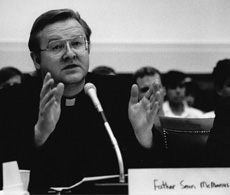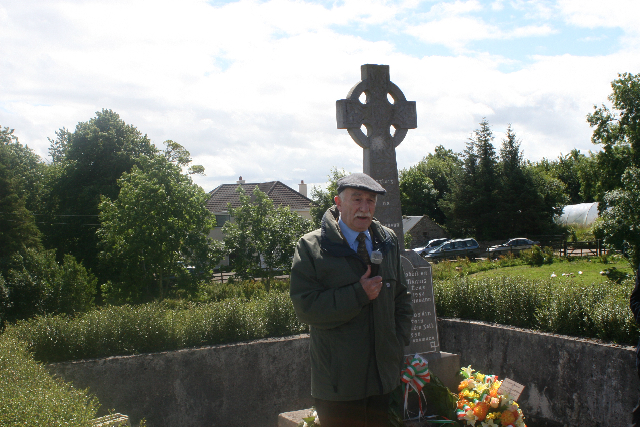The Patrick Mc Manus 50th Anniversary Oration
Posted By: March 29, 2013
By
Noel Kavanagh
At the Monument that marks the spot where Patrick Mc Manus was killed in the townland of Derryrealt, a few miles outside Swanlinbar, County Cavan.The surviving Veterans of the 1956-1962 IRA campaign held a wreath laying ceremony at the Monument on July 15, 2008.
Noel Kavanagh was the OC of the Teeling Flying Column*.
Mc Manus, aged 29, was killed on July 15, 1958 in a premature explosion.
(Noel Kavanagh at the grave of Patrick McManus)
Failte romhaibh go leir a chaired agus a shean laochra Oglaig na h- Eireann.
I particularly wish to welcome here today members of the McManus family.
When the volunteers of the Teeling Column * arrived in Co. Fermanagh in December 1956, we were introduced to our fellow volunteers in the county as men who had come to help free Fermanagh from the British occupation. The response was, “men you could not have come on a better errand”.
Pat McManus of Kinawley was an exceptional, and dedicated man and radiated self-confidence with a thorough knowledge of his local terrain. These qualities transmitted to me as Officer Commanding and to the other members of the column. As O.C. of the South Fermanagh volunteers he helped tremendously in the integration of his men with those of the Teeling Column.
Represented in the expanded force were volunteers from Fermanagh, Cavan and Leitrim (already an integrated force group). Counties Dublin, Meath, Mayo, Galway and Longford. Pat and his men exhibited organized ingenuity in all their work with the column. Sadly, as you all know, the Southern volunteers were subsequently betrayed the Irish Government.
One has to ask why, 40 years after the 1916 Rising in Dublin and the War of Independence 1918-1921, determined volunteers took to arms once more. If 1916-1921 was the first stage of that war the 1956 campaign was the beginning of the second phase.
The British Government of Ireland Act 1920 enforced the establishment of Stormont as a one party government of Unionists for Unionists, maintained by an armed militia and by its Special Powers Act, of which even the South African apartheid government, under Hendrick Verwoerd, was envious. The gerrymandering in constituencies to maintain political control and domination, the housing and job discrimination, the forced emigration and the isolation of the Irish people in these six counties from their compatriots in the South, the ongoing cultural discrimination, the forced emigration and the isolation of the Irish people in these six counties from their compatriots in the South, the ongoing cultural discrimination-all these factors combined- in an almost fascist regime, had to be opposed by force in the deliberately contrived absence of a legitimate political opportunity to do so. Pat saw this clearly and took his stand. He led the opposition to this regime in Co. Fermanagh.
Now in 2008 the situation has changed utterly and there is now an established political format through the will of all the people. Pat and the McManus family have, of course, a tremendous Ulster Heritage.
The great Ulster annalist Cathal Og McManus was born in 1438 and in the early 1460’s commenced the compilation of the Annals of Ulster
(431-1588) along with the scribe Rory O Luinin, he gathered all the known Ulster manuscript material in existence at that time and worked upon his chronicle until his death in 1498. O Luinin continued the Annals into the early 16th century and Rory O Cassidy added further contemporary records to his. This process continued to at least 1588 and the annals were still on the island of Ballymacmanus, Lough Erne, when Michael O Clerig and his colleagues consulted them between
1632-34 for their great opus, the Annals of the Four Masters. (Both sets of Annals are published by the de Burca Publishers). One trusts that the re-published Annals are now in the Public Library in Enniskillen, the former seat of the Maguires.
That island name, Ballymacmanus, was changed deliberately to Belle Isle in the 18th century. Every island on Lough Erne is a belle isle so one can conclude that the change was made to purge the McManus name from the topography of this beautiful country.
I have no doubt that you all recall from school days, the historic event that took place in the Pass of Termopolae in Greece when 300 Spartans died in defense of their country when invaded by the Persians. There is a monument there today which has the following
epigram:
“Go tell the Spartans, passers by,
That in obedience to their laws,
Here we died”.
If I may paraphrase that epigram for our comrade in arms, Pat McManus, I suggest the following:
Go tell the people of Ireland
All who gather here,
That for the love of Justice, Equality and Fraternity, Pat McManus died here.
MAY HE NOW REST IN PEACE.
* The Teeling Column- Named after the Teeling Brothers, Bartholomew and Charles, born at Lisburn, Co. Antrim, both United Irishmen, Bartholomew was executed at Arbour Hill Barracks, Dublin, 21st September 1798. Charles died in Dublin in 1850.











